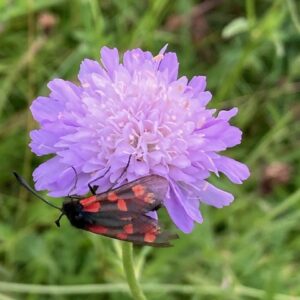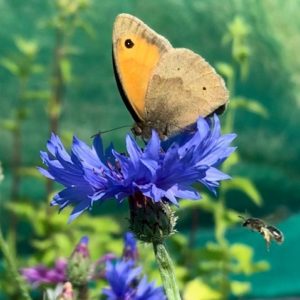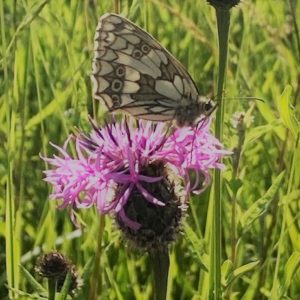
Field scabious

Cornflower

Common knapweed
Butterfly numbers have been severely hit in recent years due to loss of habitat and some very wet summers. Planting wildflowers is a way of helping them and also gives you the pleasure of seeing more butterflies in your garden. We all know that nectar plants are important and there are many garden flowers and wild flowers which produce lots of nectar. If you are planting cultivated varieties in your garden choose the single rather than double varieties as the doubles often produce no nectar at all.
Nectar is important for the adult butterfly but what about the caterpillars? They also need food plants and each adult butterfly has to seek out particular plants to lay their eggs. When the eggs hatch the caterpillars emerge and find themselves on their correct food plant so they can start eating straight away. The more common butterflies are not too fussy. The ‘Cabbage’ whites are not short of food and the Meadow Brown, Ringlet and Gatekeeper caterpillars feed on common plants such as grasses, ragwort and bramble. The Red Admiral and Peacock are fairly common in our gardens and their caterpillars feed on nettles, the Painted Lady prefers thistles.
It is the less common butterflies which are suffering most from habitat loss because their food plants are rarer now in the wild and only the true wildflower will do. Here are some examples along with the caterpillars that rely on them:
Birdsfoot trefoil: Common blue, Green hairstreak, Dingy skipper, Wood white, Clouded yellow, Brown argus
Dog violet: Small pearl-bordered fritillary, Pearl-bordered fritillary, High brown fritillary, Dark green fritillary, Silver washed fritillary
Buckthorn (and Alder buckthorn): Brimstone
Agrimony (and Wild strawberry): Grizzled skipper,
Meadow vetchling: Wood white
Hemp agrimony: Small tortoiseshell and Red admiral
Knapweed: Marbled white
Primrose: Pearl-bordered fritillary, Duke of Burgundy
Wild thyme (& Wild marjoram): Large blue
Red clover : Clouded yellows, Mazarine blue, Short-tailed blue
Devils bit scabious (& Field scabious): Marsh fritillary
A full list is available on www.ukbutterflies.co.uk/foodplants.php
If you enjoy spotting butterflies why not sign up to irecord and add your findings to the national database: www.brc.ac.uk/irecord
To help you identify the butterflies in your garden visit the butterfly conservation page to identify your butterfly.
It’s best to plant several clumps or drifts of one species so that there is plenty available. You could also do some research to find out which species are struggling in your area. Do the butterflies a favour and plant some wild flowers in your garden this year.
For more ideas to help Butterflies survive and thrive in your garden, visit the butterfly conservation to find more tips for Attracting Butterflies to your garden
